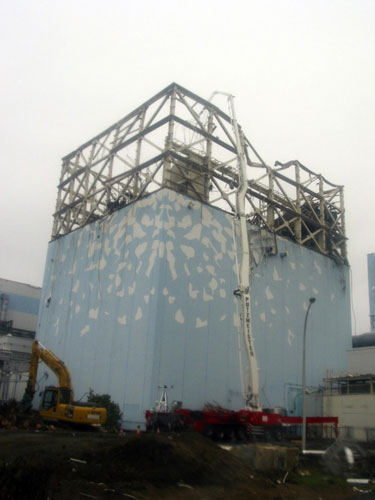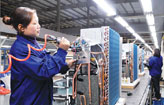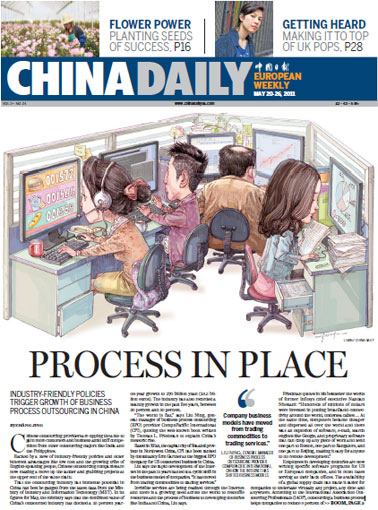Asia
UN probe into Japan's crippled nuke plant
Updated: 2011-05-24 21:02
(Agencies)
 |
|
Sampling of radioactive materials in the air above Tokyo Electric Power Co. (TEPCO)'s Fukushima Daiichi nuclear power plant No 1 reactor building is carried out in Fukushima, northern Japan, in this handout photo taken May 22, 2011 and released by TEPCO on May 24, 2011. [Photo/Agencies] |
TOKYO - A major international mission to investigate Japan's flooded, radiation-leaking nuclear complex opened Tuesday as new information emerged on just how serious the crisis was in the early days after the March 11 tsunami.
The team of UN nuclear experts met with Japanese officials and were to inspect the Fukushima Dai-ichi plant in coming days to investigate the worst nuclear accident since Chernobyl in 1986 and assess efforts to stabilize the complex by Tokyo's self-declared deadline of early next year.
The Japanese government, which has pledged to cooperate with the experts from the Vienna-based International Atomic Energy Agency, also announced its own probe into the crisis, appointing a Tokyo academic to head an investigative panel.
The plant operator, Tokyo Electric Power Co., released new analysis suggesting that fuel rods in the plant's Units 2 and 3 mostly melted during the early days of the crisis, which had been suspected but could not be confirmed and which suggests the severity of the accident was greater than officials have acknowledged. TEPCO announced similar findings last week about Unit 1.
The new revelations indicate that earlier official assessments may have been too optimistic, said Goshi Hosono, director of Japan's nuclear crisis task force.
"We should have made a more cautious damage estimate based on a worse scenario," he said.
Fuel in three of the plant's six reactors started melting after the March 11 tsunami knocked out cooling systems, prompting huge releases of radiation into the atmosphere - about one-tenth of the radiation released from the Chernobyl disaster in 1986, according to a government estimate.
The plant is still leaking, but at much lower levels than immediately after the accident, and Japanese officials hope to bring the entire plant into "cold shutdown" - halting all radioactive leaks - by January at the latest.
In the meantime, 80,000 people remain evacuated from homes around the plant. Many are living in school gymnasiums. A handful of stalwarts have defied government orders and refused to leave.
"TEPCO caused such a horrible disaster. Leaving my home means I have lost to TEPCO," said Naoto Matsumura, a 51-year-old rice and vegetable farmer who has stayed at his home despite radiation concerns and a lack of electricity and running water.
"Certainly, the life is not comfortable at all," he said. "But I will not give up."
Violators of a 12-mile (20-kilometer) exclusion zone could face fines up to 100,000 yen ($1,200) or detention of 30 days, but no officials have moved to arrest him, he said.
The IAEA team conferred Tuesday with Japan's economy and trade minister, whose ministry oversees - and promotes - the nuclear industry, and will visit Japan through June 2 before reporting to an international conference in Vienna on June 20.
Michael Weightman, leader of the IAEA team, said the delegation would "seek information to see how the world can learn lessons from the unfortunate events here."
Hosono said the IAEA team submitted a "long list" of questions, which he said authorities would do their best to answer.
The government also said it was appointing University of Tokyo professor Yotaro Hatamura, an expert on industrial and other accidents, to head a panel of outside experts to investigate the Fukushima accident.
The crisis has raised serious questions about the lax oversight of Japan's nuclear industry and prompted the country to scrap plans to rely on nuclear power for one half its electricity needs - up from its current one third.
The quake and tsunami, which left 24,000 people dead or missing, also damaged farms, ports and hundreds of suppliers, helping to push Japan's economy back into recession.
A clearer picture of the extent of damage at the plant emerged Tuesday after an analysis of data from Units 2 and 3 suggested that fuel rods in those two cores had almost certainly mostly melted as well.
"We have analyzed data, which showed that it was highly likely that most of the fuel rods have melted. But it is unlikely that melting fuel rods could worsen the crisis because the melted fuels are covered in water," said Takeo Iwamoto, a company spokesman.
Of the remaining reactors at the plant, Unit 4 had no fuel rods inside its core at the time of the tsunami, but workers have struggled to keep cool its cache of used fuel rods. Units 5 and 6 were brought into a cold shutdown in late March.
E-paper

Thawing out
After a deep freeze in sales during the recession, China’s air conditioner makers are bouncing back
Cool Iron lady
Of good and evil
Build on security initiatives
Specials

Memory lanes
Shanghai’s historic ALLEYS not just unique architecture but a way of life

Great expectations
Hong Kong-born singer songwriter rises to the top of the UK pops.

A diplomat of character
Belgian envoy draws on personal fascination to help build China ties.
